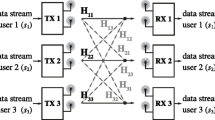Abstract
A comparison of wideband communication characteristics for five different geometrical configurations of corridors at 57.5 GHz is investigated. Shooting and bouncing/image techniques are applied to compute the impulse responses for: (i) the straight shape corridor with rectangular cross section (ii) the straight shape corridor with arched cross section (iii) the curved shape corridor with rectangular cross section (iv) the curved shape corridor with arched cross section and (v) the L-shape corridors. By using the impulse responses of these multipath channels, the outage probabilities for high-speed BPSK (binary phase shift keying) systems with phase and timing recovery circuits are calculated. Numerical results show that the outage probability for the L-shape corridor is the largest among all the five configurations being studied. Also, the outage probabilities for the arched cross section corridors are smaller than those for the rectangular cross section corridors regardless of the shapes. In addition, the effect of space antenna diversity techniques on mitigating the multipath fading is also investigated. Finally, it is with noting that in these cases the present work provides not only comparative information but also a quantitative information on the performance reduction.
Similar content being viewed by others
References
A.M. Hammoudeh and G. Allen, “Millimetric Wavelengths Radiowave Propagation for Line-of-Sight Indoor Microcellular Mobile Communications”, IEEE Trans. Veh. Technol., Vol. 44, pp. 449–460, 1995.
T. Manabe, Y. Miura and T. Ihara, “Effects of Antenna Directivity and Polarization on Indoor Multipath Propagation Characteristics at 60 GHz”, IEEE J. Select. Areas Commun., Vol. 14, pp. 441–448, 1996.
A.A.M. Saleh and R.A. Valenzuela, “A Statistical Model for Indoor Multipath Propagation”, IEEE J. Select. Areas Commun., Vol. 5, pp. 128–137, 1987.
S.H. Chen and S.K. Jeng, “An SBR/Image Approach for Indoor Radio Propagation in a Corridor”, IEICE Trans. Electron., Vol. E78-C, pp. 1058–1062, 1995.
S.H. Chen and S.K. Jeng, “SBR/Image Approach for Radio Wave Propagation in Tunnels With and Without Traffic”, IEEE Trans. Veh. Technol., Vol. 45, pp. 570–578, 1996.
F.J. Harris, “On the Use of Windows for Harmonic Analysis With the Discrete Fourier Transform”, Proc. IEEE, Vol. 66, pp. 51–83, 1978.
L.J. Greenstein and B.A. Czekaj-Augun, “Performance Comparisons Among Digital Radio Techniques Subjected to Multipath Fading”, IEEE Trans. Commun., Vol. 30, pp. 1184–1197, 1982.
J.C. Chuang, “The Effects of Multipath Delay Spread on Timing Recovery”, IEEE Trans. Veh. Technol., Vol. 35, pp. 135–140, 1987.
N. Amitay and L.J. Greenstein, “Multipath Outage Performance of Digital Radio Receivers Using Finite-Tap Adaptive Equalizers”, IEEE Trans. Commun., Vol. 32, pp. 597–608, 1984.
K. Pahlavan, “Comparison Between the Performance of QPSK, SQPSK, QPR, and SQPR Systems over Microwave LOS Channels”, IEEE Trans. Commun., Vol. 33, pp. 291–296, 1985.
K. Sato, T. Manabe, T. Ihara, H. Saito, S. Ito, T. Tanaka, K. Sugai, N. Ohmi, Y. Murakami, M. Shibayama, Y. Konishi and T. Kimura, “Measurements of Reflection and Transmission Characteristics of Interior Structure of Office Building in the 60 GHz Band”, in Proc. IEEE International Symposium on Personal, Indoor and Mobile Radio Communication, Vol. 1, Oct. 1996, pp. 14–18.
J. Lahteenmaki and T. Karttaavi, “Measurement of Dielectric Parameter of Wall Materials at 60 GHz Band”, Electron. Lett., Vol. 32, pp. 1442–1444, 1996.
T.S. Rappaport, Wireless Communications, Prentice-Hall, 1996.
Y. Roy, J.Y. Chouinard and S.A. Mahmound, “Selection Diversity Combining with Multiple Antennas for MM-Wave Indoor Wireless Channels”, IEEE J. Select. Areas Commun., Vol. 14, pp. 674–682, 1996.
G.A. Kalivas, M. El-Tanany and S. Mahmond, “Millimeter-Wave Channel Measurements with Space Diversity for Indoor Wireless Communications”, IEEE Trans. Veh. Technol., Vol. 44, pp. 494–505, 1995.
Author information
Authors and Affiliations
Rights and permissions
About this article
Cite this article
Chiu, CC., Wang, CP. A Comparison of Wideband Communication Characteristics for Various Corridors at 57.5 GHz. Wireless Personal Communications 12, 71–81 (2000). https://doi.org/10.1023/A:1008825927352
Issue Date:
DOI: https://doi.org/10.1023/A:1008825927352




